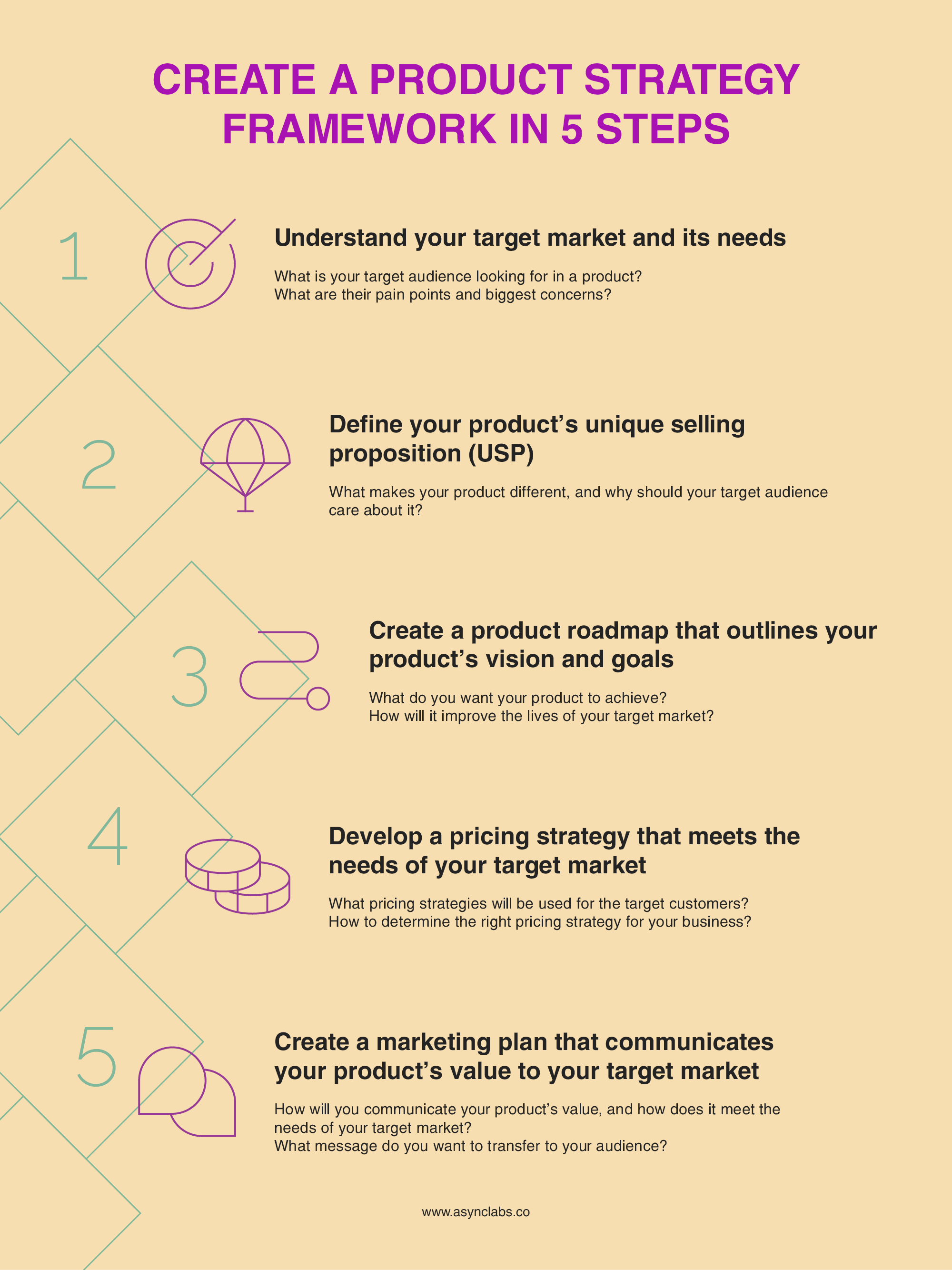A successful product strategy framework is the key to a thriving business. It allows you to identify and target your ideal customer, create a unique selling proposition, and develop a roadmap for your product that aligns with your business goals.
You may have a great product, but success is not guaranteed if you don’t have a product strategy framework. This will allow you to make better decisions about your products and their positioning in the market.
But what is a product strategy framework? And more importantly, why is it important for business?
In this post, we’ll answer these questions and walk you through the steps you need to take to create a product strategy framework to help you achieve your business goals.
So, whether you’re already in a business or just starting, read on for tips and advice to help you take your product to the next level.
What is a product strategy?
A product strategy is a plan that outlines how a company will create, market, and sell a product. It’s an essential document for businesses as it lays out the goals and objectives for a product and how it will be positioned in the market.
A well-developed product strategy can have many benefits for a business. It can help to ensure that products are aligned with the company’s overall strategy, make it easier to prioritize products and initiatives, and help to guide decision-making around new products.
Why is a product strategy important for businesses?
A product strategy is important for businesses because it ensures they focus their efforts on the right products. By developing a product strategy framework, you can be sure that you are taking all the necessary steps to create and execute a successful product strategy.
A product strategy framework can help in the following:
- Clarifying focus on what products to develop and market
- Increasing efficiency in developing products
- Better communication and coordination among team members
- Improving decision making
- Reducing the risk of launching products that are not successful
What are the benefits of a product strategy framework?
There are all sorts of different product strategy frameworks out there, but they all have the same primary goal: to help you develop a clear plan for how your product will compete in the market and make money from it.
Each framework has its benefits and drawbacks, so choosing one that will fit your business and your products is essential. Once you’ve selected a framework, you can use it to help you make key decisions about your product, such as what features to build, what markets to focus on, and how to price and sell your product.
There are several benefits to using a product strategy framework. Here are some of the most important:
- It provides a roadmap for product development.
- Helps ensure that all products are aligned with the company’s overall business objectives.
- Facilitates communication between different teams (marketing, sales, etc.)
- Enables you to make data-driven decisions about your products.
- Helps you track progress and measure results.
How to develop a product strategy framework step by step?
Creating a product strategy framework is essential to success in the product development process.
There are five steps to developing a product strategy framework:
1. Identify your product’s target market and understand their needs.
2. Define your product’s unique selling proposition (USP).
3. Create a product roadmap that outlines your product’s vision and goals.
4. Develop a pricing strategy that meets the needs of your target market.
5. Create a marketing plan that communicates your product’s value to your target market.
Following these five steps, you can create a strategy to help your product reach its target market and achieve desired results.

01. Understand your target market and its needs
First, you must understand your target market and its needs when creating a product strategy. What is your target audience looking for in a product? What are their pain points and biggest concerns?
Once you clearly understand your target market’s needs, you can begin to define your product’s unique selling proposition (USP).
Ask yourself the following questions:
- What differentiates your product from the competition?
- Why should consumers choose your product over the others?
With a solid understanding of your target market and USP, you can create a Product Roadmap outlining your product’s vision and goals. This will help keep you on track as you develop and launch your product.
Finally, it’s important to create a pricing strategy that meets the needs of your target market. It will be difficult to sell if your product is overpriced or underpriced. Make sure to research your competition and find the right price point to make your product attractive to consumers.
With a well-defined product strategy, you’re ready to launch your product into the world!
02. Define your product’s unique selling proposition (USP)
What makes your product different, and why should your target market care? This is where you define your product’s unique selling proposition (USP).
Your USP should be something that sets your product apart from the competition and makes it a must-have for your target market. It could be a new feature, a lower price, or an unbeatable warranty. Whatever it is, make sure it’s something that matters to your target market.
03. Create a product roadmap that outlines your product’s vision and goals
When creating your product roadmap, it’s essential to consider your product’s vision and goals. What do you want your product to achieve? How will it improve the lives of your target market?
Your roadmap should also outline specific goals that you want your product to achieve. For example, you may want to increase sales by 20% within the next six months. Or you may want to introduce a new feature that will make your product stand out from the competition.
You may need to adjust your goals and strategies as your product evolves. But a roadmap will help you stay on track and reach your objectives. The roadmap should also be flexible to be updated as needed.
04. Develop a pricing strategy that meets the needs of your target market
When pricing your product, you need to find a balance that meets your target market’s and your business’s needs. You want to ensure that you’re charging a fair price that makes sense for your product while also making a profit.
There are a few things to keep in mind when setting your price:
- Don’t undercut your competition. If you charge too little, you’ll be seen as a low-quality option and lose out to more established brands.
- Don’t overprice your product. You’ll turn away potential customers and lose market share.
- Research what other products in your category are charging and find a price in the middle.
Consider these things when developing your pricing strategy, and remember to adjust as needed to stay competitive and reach your target market.
05. Create a marketing plan that communicates your product’s value to your target market
When marketing your product, you must consider your target market and what you want them to know about it. Your marketing strategy should communicate your product’s value and how it meets the needs of your target market.
You can use several marketing channels to reach your target markets, such as online advertising, PR, social media, and email marketing. It’s important to tailor your marketing strategy to the channels your target market is most likely to use.
When creating your marketing plan, think about the overall tone and message you want to communicate. Your marketing materials should be clear, concise, and easy to understand. And most importantly, they should speak to the needs of your target market.
Launch your product and track your results
You’ve just learned about the product strategy framework and some of the benefits it can have for your business. Now it’s time to develop a product strategy framework step by step and launch your product.
Use analytics to track your product’s performance and evaluate how well it’s meeting the needs of your target market. It is important to track your results and continually update your product strategy framework as your product and market evolve.
Make sure you have a plan to track your product’s success and make changes as needed. The key to success is being flexible and willing to adapt as needed.
Understanding your company’s goals and objectives is key to developing a product strategy. Once you clearly understand what you’re trying to achieve, you can begin to create a product strategy that will help you reach those goals.
With the proper knowledge and tools, you are on an excellent way to bringing your product to market and achieving success. If you need professional expertise, Async Labs is at your fingertips. Stand out in a digital world and do your best to exceed your marketing goals. Send an email and let us help you build your product strategy framework today.
